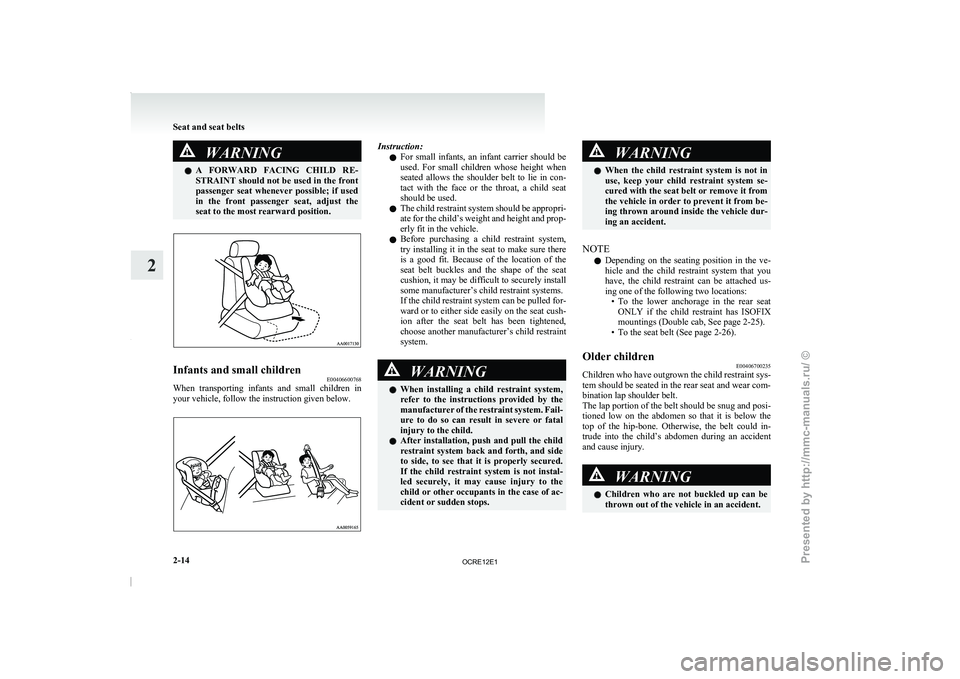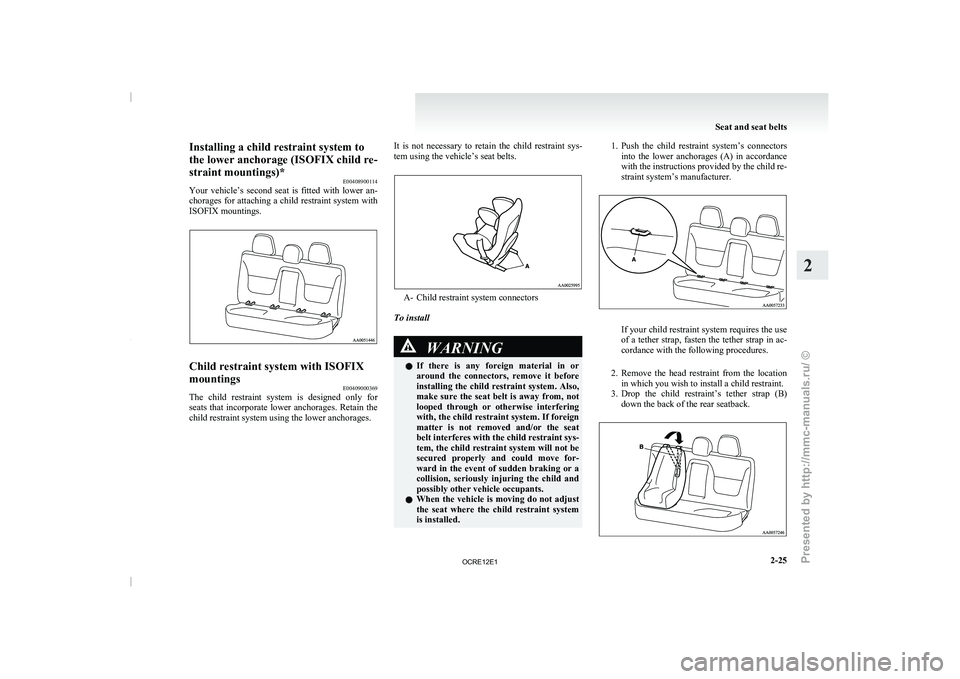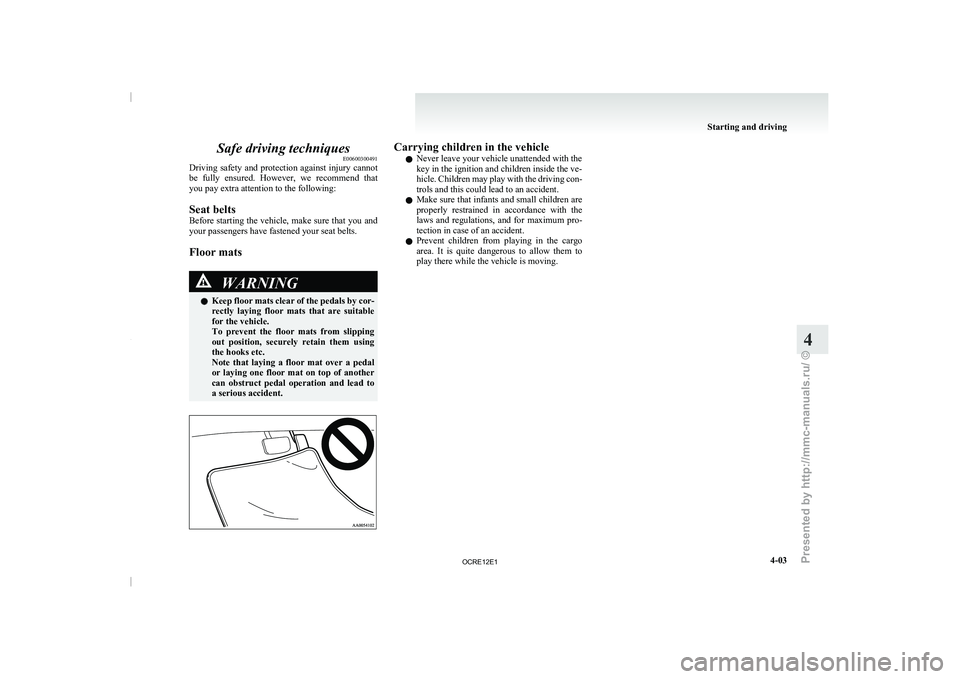2011 MITSUBISHI TRITON ECU
[x] Cancel search: ECUPage 59 of 369

WARNING
l A FORWARD FACING CHILD RE-
STRAINT should not be used in the front
passenger seat whenever possible; if used
in the front passenger seat, adjust the
seat to the most rearward position. Infants and small children
E00406600768
When transporting infants and small children in
your vehicle, follow the instruction given below. Instruction:
l For small infants, an infant
carrier should be
used. For small children whose height when
seated allows the shoulder belt to lie in con-
tact with the face or the throat, a child seat
should be used.
l The child restraint system should be appropri-
ate for the child’s weight and height and prop-
erly fit in the vehicle.
l Before purchasing a child restraint system,
try installing it in the seat to make sure there
is a good fit. Because of the location of the
seat belt buckles and the shape of the seat
cushion, it may be difficult to securely install
some manufacturer’s child restraint systems.
If the child restraint system can be pulled for-
ward or to either side easily on the seat cush-
ion after the seat belt has been tightened,
choose another manufacturer’s child restraint
system. WARNING
l When installing a child
restraint
system,
refer to the instructions provided by the
manufacturer of the restraint system. Fail-
ure to do so can result in severe or fatal
injury to the child.
l After installation, push and pull the child
restraint system back and forth, and side
to side, to see that it is properly secured.
If the child restraint system is not instal-
led securely, it may cause injury to the
child or other occupants in the case of ac-
cident or sudden stops. WARNING
l When the child restraint system
is not in
use, keep your child restraint system se-
cured with the seat belt or remove it from
the vehicle in order to prevent it from be-
ing thrown around inside the vehicle dur-
ing an accident.
NOTE l Depending
on the seating position
in the ve-
hicle and the child restraint system that you
have, the child restraint can be attached us-
ing one of the following two locations: • To the lower anchorage in the rear seatONLY if the child restraint has ISOFIX
mountings (Double cab, See page 2-25).
• To the seat belt (See page 2-26).
Older children E00406700235
Children who have outgrown the child restraint sys-
tem should be seated in the rear seat and wear com-
bination lap shoulder belt.
The lap portion of the belt should be snug and posi-
tioned low on the abdomen
so that it is below the
top of the hip-bone. Otherwise, the belt could in-
trude into the child’s abdomen during an accident
and cause injury. WARNING
l Children who are not
buckled
up can be
thrown out of the vehicle in an accident. Seat and seat belts
2-14
2
OCRE12E1
Presented by http://mmc-manuals.ru/ \251
Page 69 of 369

Child restraint anchorage points (Dou-
ble cab)*
E00406900354
Anchorage locations
There are 2 child restraint
anchorage points on the
floor, located behind the rear seat. These are for se-
curing a child restraint system tether strap to each
of the 2 rear seating positions in your vehicle. *: Rear of the vehicle
CAUTION
l
The anchorages are only
applicable
for
child restraints fitted in the rear seat. Tether anchorage strap installation WARNING
l Child restraint anchorages are
designed
to
withstand only those loads imposed by
correctly fitted child restraints. Under no
circumstances are they to be used for
adult seat belts, harnesses, or for attach-
ing other items or equipment to the vehicle.
1. Remove the head restraint from the location
in which you wish to install a child restraint.
2. Drop
the child
restraint’s tether strap (A)
down the back of the rear seatback. 3. Tip the armrest forward. Open the fastener
(B) that is located
in the space where the arm-
rest was stowed. 4. Put your hand in the opening of the fastener,
attach the tether strap’s hook (C) to the tether
anchorage (D), and securely
tighten the teth-
er strap. Seat and seat belts
2-24
2
OCRE12E1
Presented by http://mmc-manuals.ru/ \251
Page 70 of 369

Installing a child restraint system to
the lower anchorage (ISOFIX child re-
straint mountings)*
E00408900114
Your vehicle’s second seat is
fitted with lower an-
chorages for attaching a child restraint system with
ISOFIX mountings. Child restraint system with ISOFIX
mountings
E00409000369
The child restraint system is designed only for
seats that incorporate lower anchorages.
Retain the
child restraint system using the lower anchorages. It is not necessary to retain the child restraint sys-
tem using the vehicle’s seat belts. A- Child restraint system connectors
To install WARNING
l If there is any
foreign
material in or
around the connectors, remove it before
installing the child restraint system. Also,
make sure the seat belt is away from, not
looped through or otherwise interfering
with, the child restraint system. If foreign
matter is not removed and/or the seat
belt interferes with the child restraint sys-
tem, the child restraint system will not be
secured properly and could move for-
ward in the event of sudden braking or a
collision, seriously injuring the child and
possibly other vehicle occupants.
l When the vehicle is moving do not adjust
the seat where the child restraint system
is installed. 1. Push the child restraint system’s connectors
into the lower anchorages
(A) in accordance
with the instructions provided by the child re-
straint system’s manufacturer. If your child restraint system requires the use
of a tether strap,
fasten
the tether strap in ac-
cordance with the following procedures.
2. Remove the head restraint from the location in which you wish to install a child restraint.
3. Drop the child restraint’s tether strap (B) down the back of the rear seatback. Seat and seat belts
2-25 2
OCRE12E1
Presented by http://mmc-manuals.ru/ \251
Page 71 of 369

4. Tip the armrest forward. Open the fastener
(C) that’s located in the space where the arm-
rest was stowed. 5. Put your hand in the opening of the fastener,
attach the tether strap’s
hook (D) to the teth-
er anchorage (E), and securely tighten the teth-
er strap. 6. Push and pull the child restraint system in all
directions to be sure it is firmly secured. To remove
Remove the child restraint in
accordance with the
instructions provided by the child restraint sys-
tem’s manufacturer.
Installing a child restraint system to a
3-point type seat belt (with emergency
locking mechanism) E00408700516
Single cab and Club cab
Double cab
Front passenger seat
Front passenger seat Installation:
1. Fasten the seat belt to
secure the child re-
straint system.
Make sure you hear a “click” when you in-
sert the latch plate in the buckle.
2. Remove all slack by using the locking clip.
3. Push and pull the child restraint in all direc- tions to be sure it is secure. WARNING
l For some types of child
restraint, the lock-
ing clip (A) should be used to help avoid
personal injury during a collision or sud-
den manoeuvre.
It must be fitted and used in accordance
with the child restraint manufacturer’s in-
structions.
The locking clip must be removed when
the child restraint is removed. Seat and seat belts
2-26
2
OCRE12E1
Presented by http://mmc-manuals.ru/ \251
Page 128 of 369

Safe driving techniques
E00600300491
Driving safety and protection against
injury cannot
be fully ensured. However, we recommend that
you pay extra attention to the following:
Seat belts
Before starting the vehicle, make sure that you and
your passengers have fastened your seat belts.
Floor mats WARNING
l Keep
floor
mats clear
of
the pedals by cor-
rectly laying floor mats that are suitable
for the vehicle.
To prevent the floor mats from slipping
out position, securely retain them using
the hooks etc.
Note that laying a floor mat over a pedal
or laying one floor mat on top of another
can obstruct pedal operation and lead to
a serious accident. Carrying children in the vehicle
l Never leave your vehicle unattended with the
key in the ignition and children inside the ve-
hicle. Children may play
with
the driving con-
trols and this could lead to an accident.
l Make sure that infants and small children are
properly restrained in accordance with the
laws and regulations, and for maximum pro-
tection in case of an accident.
l Prevent children from playing in the cargo
area. It is quite dangerous to allow them to
play there while the vehicle is moving. Starting and driving
4-03 4
OCRE12E1
Presented by http://mmc-manuals.ru/ \251
Page 134 of 369

Steering wheel height adjustment
E00600700219
To adjust the steering wheel
height, release the tilt
lock lever while holding the steering wheel by
hand, and raise or lower the steering wheel to the
desired height.
After adjustment, securely lock the lever by pulling
it upward. 1- Locked
2- Release
WARNING
l After adjusting to the
desired
height,
check to be sure that the lever is locked.
l Do not attempt to adjust the steering
wheel while you are driving the vehicle.
l When releasing the tilt lock lever, move it
to the release position (2) and hold the
steering wheel by hand to prevent it fall-
ing to the lowest position. Inside rear-view mirror
E00600800106
Adjust the rear-view mirror only
after making any
seat adjustments so you have a clear view to the
rear of the vehicle. WARNING
l Do not attempt to
adjust
the rear-view
mirror while driving. This can be danger-
ous.
Always adjust the mirror before driving.
Adjust the rear-view mirror to maximize the view
through the rear window.
To adjust the vertical mirror position
It is possible
to move
the mirror up and down to ad-
just its position. To reduce the glare
The lever (A) at
the
bottom of the mirror can be
used to adjust the mirror to reduce the glare from
the headlamps of vehicles behind you during night
driving. 1- Normal
2- Anti-glare Starting and driving
4-09 4
OCRE12E1
Presented by http://mmc-manuals.ru/ \251
Page 148 of 369

Sports mode
E00603901251
Whether the vehicle is stationary
or in motion,
sports mode is selected by gently pushing the selec-
tor lever from the “D” (DRIVE) position into the
manual gate (A). To return to “D” range operation,
gently push the selector lever back into the main
gate (B).
In sports mode, gear shifts can be made rapidly sim-
ply by moving the selector lever backward and for-
ward. In contrast to a manual transmission, the
sports mode allows gear shifts with the accelerator
pedal depressed.
SHIFT UP
SHIFT DOWN + (SHIFT UP)
Push the lever forward
once
to shift up one gear.
- (SHIFT DOWN)
Pull the lever backward once to shift down one
gear. CAUTION
l
In sports mode, the driver
must execute
upward shifts in accordance with prevail-
ing road conditions, taking care to keep
the engine speed below the red zone.
l By rapidly moving the selector lever back-
ward (SHIFT DOWN) twice, it is possible
to skip one gear, i.e., 3 rd
to 1 st
, 4 th
to 2 nd
or 5 th
to 3 rd
. Since sudden engine braking
and/or rapid acceleration can cause a loss
of traction, downshifts must be made care-
fully in accordance with the vehicle’s
speed.
NOTE l In
sports mode, only the
5 forward gears can
be selected. To reverse or park the vehicle,
move the selector lever to the “R” (RE-
VERSE) or “P” (PARK) position as required.
l To maintain good running performance, the
transmission may refuse to perform an up-
shift when the selector lever is moved to the
“+ (SHIFT UP)” position at certain vehicle
speeds. Also, to prevent over-revving of the
engine, the transmission may refuse to per-
form a downshift when the lever is moved to
the “- (SHIFT DOWN)” position at certain
vehicle speeds.
l In sports mode, downward shifts are made au-
tomatically when the vehicle slows down.
When the vehicle stops, 1 st
gear is automati-
cally selected. l
When
driving away on
a
slippery road, push
the selector lever forward into the “+ (SHIFT
UP)” position. This causes the transmission
to shift into the 2 nd
gear which is better for
smooth driving away on a slippery road.
Push the selector lever to the “- (SHIFT
DOWN)” side to shift back to the 1 st
gear.
Sports mode indicator E00612300355
In sports mode, the currently selected position is in-
dicated by the indicator (A)
shown on the instru-
ment panel. Starting and driving
4-23 4
OCRE12E1
Presented by http://mmc-manuals.ru/ \251
Page 165 of 369

WARNING
l When attempting to rock your vehicle out
of a stuck position, be
sure that the area
around the vehicle is clear of people and
physical objects. The rocking motion may
cause the vehicle to suddenly launch for-
ward or backward, causing injury or dam-
age to nearby people or objects.
NOTE l Avoid
sudden braking, acceleration, and
turn-
ing; such operations could result in the vehi-
cle becoming stuck.
l If the vehicle becomes stuck in sandy or mud-
dy roads, it can often be moved a rocking mo-
tion. Move the selector lever rhythmically be-
tween the “D” (DRIVE) and “R” (RE-
VERSE) position (with M/T, between 1 st
and
Reverse), while applying slight pressure to
the accelerator pedal.
l It is recommended to start the vehicle with
parking brake partially, but not completely,
applied by slightly pulling the parking brake
lever.
After the vehicle has become free, do not for-
get to release the parking brake.
l If it is necessary to drive in extremely muddy
conditions, the use of tyre chains is recom-
mended. Because the extent of muddy condi-
tions is difficult to judge and the vehicle
could become bogged down very deeply, op-
eration should be at a low speed. If possible,
get out of the vehicle and check the condi-
tions ahead before proceeding. l
Driving over roads in
coastal
areas or roads
on which anti-skid preparations have been
spread can cause rust on the vehicle; wash
the vehicle thoroughly as soon as possible af-
ter such use.
Climbing sharp grades
Set the transfer shift lever to “4L” position (easy se-
lect 4WD), “4LLc” position (super select 4WD) to
maximize the engine torque. WARNING
l Go
straight
up. Do
not
try to traverse
across a steep slope.
l If you begin to lose traction, ease off the
accelerator pedal and gently turn the
steering wheel alternatively left and right
to regain adequate traction again.
NOTE l Choose
as smooth a slope
as possible with
few stones or other obstacles.
l Before attempting to drive up the slope, walk
up it to confirm that the vehicle can handle
the grade.
Descending sharp grades
Set the transfer shift lever to “4L” position (easy se-
lect 4WD), “4LLc” position (super select 4WD),
use the engine brake (downshifting) and descend
slowly. WARNING
l Avoid snaking down a sharp
grade. De-
scend the grade as straight as possible.
NOTE l When descending a sharp grade, if the brakes
are
applied suddenly because of
an obstacle
encountered, control of the vehicle could be
lost. Before descending the slope, walk down
it and confirm the path.
l Before descending a grade, it is necessary to
choose the appropriate gear. Avoid changing
gears or depressing the clutch while descend-
ing the grade.
l MITSUBISHI MOTORS is not responsible
to the operator for any damage or injury
caused or liability incurred by improper and
negligent operation of a vehicle. All techni-
ques of vehicle operation described herein de-
pend on the skill and experience of the opera-
tor and other participating parties and any de-
viation from the recommended operation in-
structions above is at their own risk.
Turning sharp corners
When turning a sharp corner in “4H” or “4L” posi-
tion (easy select 4WD), “4HLc” or “4LLc” posi-
tion (super select 4WD) at low speed, a slight dif-
ference in steering may be experienced similar to
as if the brakes were applied. This is called tight cor-
ner braking and results from each of the 4 tyres be-
ing at a different distance from the corner.
The phenomenon is peculiar to 4-wheel drive vehi-
cles. If this occurs, either straighten the steering
wheel, or change to rear-wheel drive. Starting and driving
4-40
4
OCRE12E1
Presented by http://mmc-manuals.ru/ \251